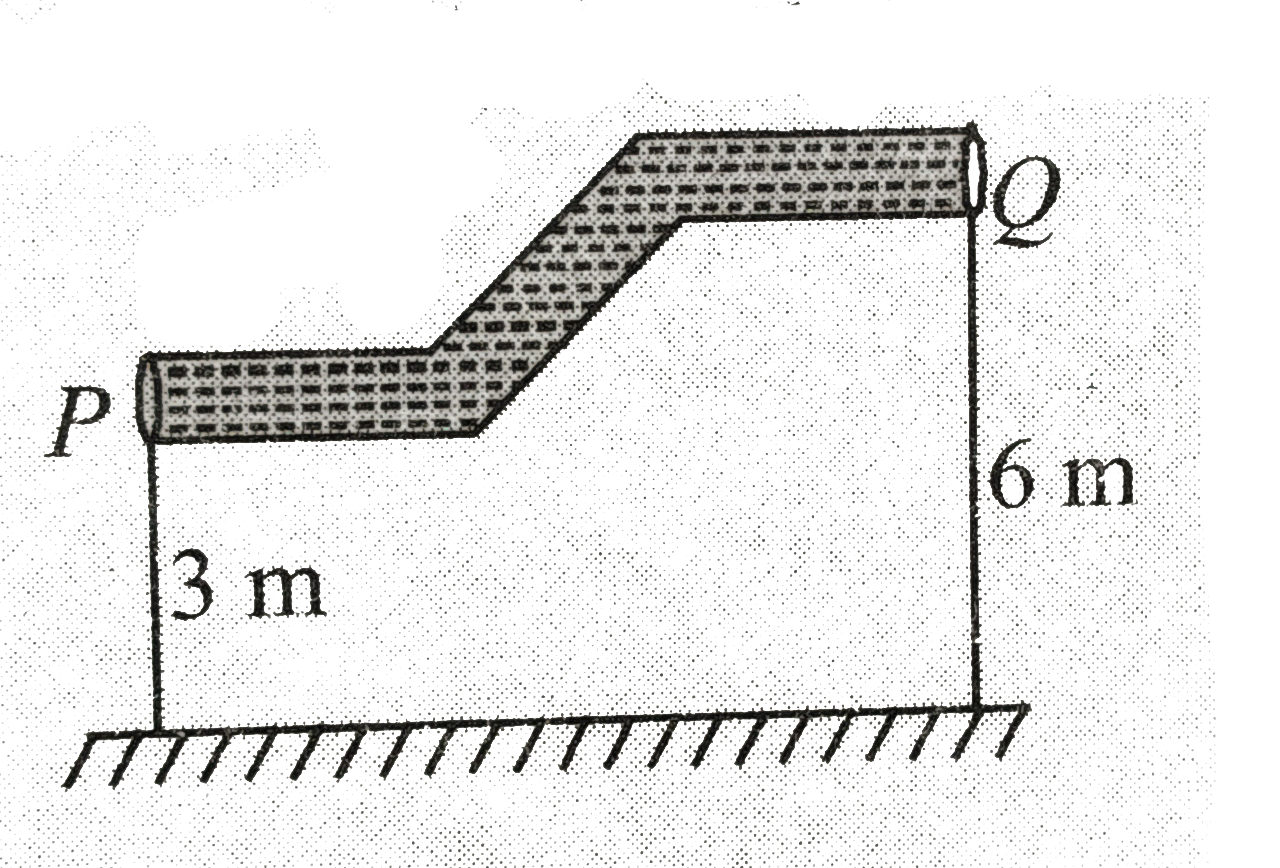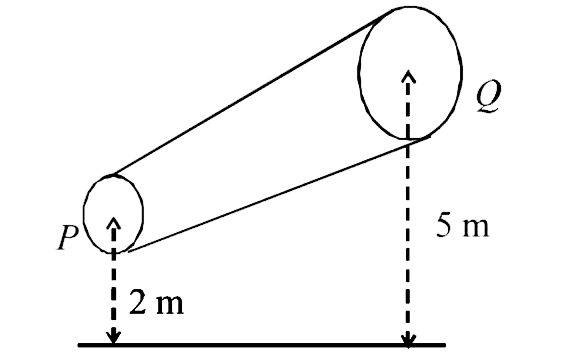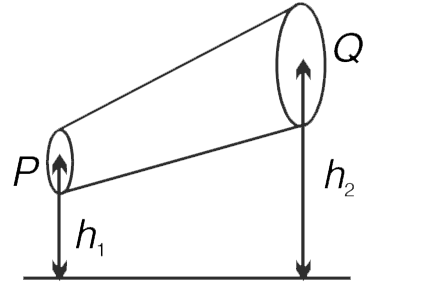A non viscous liquid of constant density 103kg/m3 flows in stream line motion along a vertical tube PQ of variable cross-section. Height of P and Q are 2m and 2.5m respectively. Area of tube at Q is equal to 3 times the area of tube at 'P'. Then work done per unit volume by pressure as liquid flows from P and Q. Speed of liquid at 'P' is 3m/s.

2000J/m3
1000J/m3
1575J/m3
9000J/m3
The correct Answer is:B
P1−P2=12ρ(v22−v21)+ρg(h2−h1)
=12×103(12−32)+103×10(0.5)
=−4×103+5×103
=1000J/m3
Similar Questions
A non-viscous liquid of constant density 500kg/m3 flows in a variable cross-sectional tube. The area of cross section of the tube at two points P and Q at heights of 3m and 6m are 2×10−3m3 and 4×10−3m3, respectively. Find the work done per unit volume by the forces of gravity as the fluid flows from point P to Q.

View SolutionA non-viscous liquid of constant density 1000kg/m3 flows in a streamline motion along a tube of variable cross section. The tube is kept inclined in the vertical plane as shown in Figure. The area of cross section of the tube two point P and Q at heights of 2 metres and 5 metres are respectively 4×10−3m2 and 8×10−3m2. The velocity of the liquid at point P is 1m/s. Find the work done per unit volume by the pressure and the gravity forces as the fluid flows from point P to Q.

View Solution
Knowledge Check
A non-viscous fluid of constant density of 1000kg/m3 flows in stream line motion along a tube of variable cross-section
 The area of cross-section at two P and Q at lengths 5m are 40cm2and20cm2 respectively. If velocity of fluid at P is 3m/s then find velocity of fluid at Q.A3m/sB4m/sC5m/sD6m/s
The area of cross-section at two P and Q at lengths 5m are 40cm2and20cm2 respectively. If velocity of fluid at P is 3m/s then find velocity of fluid at Q.A3m/sB4m/sC5m/sD6m/sA horizontal tube of non uniform cross section has radii fo 0.1 m and 0.05 m respectively at M and N,

For a streamline flow of liquid the rate of liquid flow isAcontinuously changes with timeBgreater at M then at NCgreater at N then at MDsame at M and NIf P is the pressure on a Liquid of area A and the liquid moves through a certain distance the work done per unit volume is _____.
AForceBDensityCPressureDPressure × Area
(i) Air (density=ρ) flows through a horizontal venturi tube that discharges to the atmosphere. The area of cross section of the tube is A1 and at the constriction it is A2. The constriction is connected to a water (density=ρ0) tank through a vertical pipe of lenght H. Find the volume flow rate (Q) of the air through tube that is needed to just draw the water into the tube.

(ii) A non viscous liquid of constant density ρ flows in a stremline motion along a tube of variable cross section. The tube is kept inclined in the vertical plane as shown in the figure. The area of cross section of the tube at two points P and Q at heights of h1 and h2 are respectively A1 and A2. The velocity of the liquid at point P is v. Find the work done on a small volume ΔV of fluid by the neighbouring fluid as the small volume moves from P to Q.

View SolutionA liquid of density 800kg/m3 flowing steadily in a tube of varying cross-section. If area of cross-section at A is 4cm2 and at B is 2cm2. If speed of liquid at A is 10cm/s, calculate
(i) the rate of flow
(ii) the difference in pressures at A and B.
View SolutionWaster flows throgh a horizontal tube of variable cross section.The area of cross section at A and B are 4 mm2and2mm2 respectively. If 1 cc of water enters per seconds through. A find a. The speed of water at A, b. the speed of river at B and c. the pressure difference PA−PB.

View SolutionAn incompressible, non-viscous liquis of density r flows through a horizontal tube as shown below. The flow condition is steady. Area of cross section at A and B are a1anda2 respectively. The height difference of liquid in two tubes inserted at A and B is h.

View SolutionWater flows in a stream line manner through a capillary tube of radius a. The pressure difference being P and the rate of flow is Q. If the radius is reduced to a4 and the pressure is increased to 4P. then the rate of flow becomes
View Solution
